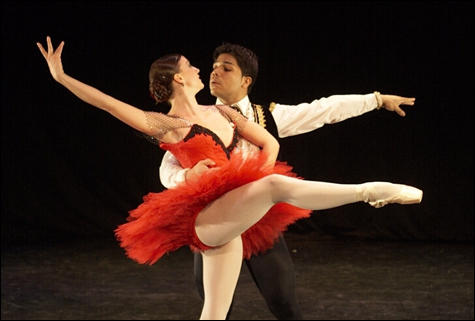
A CLASSIC: Chipp and Martinez in Don Quixote. |
Festival Ballet Providence’s “Up CLOSE, on HOPE” program is a stunning selection of short classical and contemporary ballet, performed with polish and passion. It continues March 15, 16, 22, and 29.
Audiences do indeed view these eight dances “up close,” from raised seating of only four rows. You see the faces of male dancers glistening from the exertion of lifting and leaping; you see the female dancers catch their breath and take a sip of water in the wings. But it only makes the experience that much more intense, knowing how hard the performers must work to present their art.
For art it is when Vilia Putrius presents The Dying Swan, to music by Saint-Saëns, a solo piece made famous by Anna Pavlova, with choreography by Mikhail Fokine, restaged by Festival’s ballet mistress Milica Bijelic. Putrius’s wing-like arms and the dip of her head deftly evoke the swan in its last hours.
The second classical piece is the grande pas de deux from Don Quixote, based on the original by Marius Petipa and Alexander Gorsky, to the music of Léon Minkus. Erica Chipp and Eivar Martinez accomplish the showcase leaps, in-air turns, and leg-whipping fouettés with an ease that belies the strength behind those moves.
But this “Up CLOSE” octet is dominated by contemporary pieces by Boston-based choreographers Gianni Di Marco and Viktor Plotnikov, local choreographers Colleen Cavanaugh and Mark Harootian, and NYC-based wunderkind Avichai Scher. Di Marco’s Lo Que Pasa en la Media Noche, with music by Argentinian tango-meister Astor Piazzolla, could not be more achingly sensual. Jennifer Ricci and Martinez nail the emotional depth of this duet through anguished glances and pleading looks, plus their spot-on execution of Di Marco’s unusual partnering. Martinez lifts Ricci’s limp body above his head, her legs splayed out awkwardly; her slim frame glides and slides over his body in endless variations; he walks over her curled body on the floor, slaps his thighs in frustration, and jumps up, knees tucked, as if to plunge into a pool.
The other piece that had the audience gasping in amazement was Plotnikov’s “2,” set to the rhythm-heavy electronica band Yello. Leticia Guerrero and Alexander Akulov performed this challenging dance with fierce concentration, since there seemed to be a movement for each and every beat. So fast did their bodies move that they replicated the blurred motion of drumsticks in the hands of a fever-pitch percussionist.
A reprise of Plotnikov’s 2004 Elegant Souls illuminated the expanse of his imagination. Set to classical music, it nonetheless deconstructs ballet poses and steps, stripping them to essentials and then playing riffs on them: a Chaplinesque wobble-walk, a flourish of flat palms, a clockwork swinging of arms, an undulation of abdomens. Everywhere, in every way, parts of the body break out of the classical restrictions while still paying homage to ballet’s grace and fluidity.
Cavanaugh’s Glass House, set to music by Ani DiFranco, is a tangle of angles, with Lauren Menger and Davide Vittorino swinging into long leg extensions, ducking under each other’s encircling arms, or swiveling their hips into the next step. It’s a vivid portrayal of DiFranco’s lyrics about a fractured relationship.
An even more wistful piece is Last Dance, Scher’s tribute to 22-year-old dancer Jenn Jansma, who died of cancer in February. Ashley Andries, partnered by Raemon Kilfoil, and accompanied by six other dancers, aptly conveys a sense of life as a fleeting dream.
Festival company member Mark Harootian has come up with another amusing and inventive character study, this one to songs by Dolly Parton and Patsy Cline, singing of inattentive, deceitful, or cruel lovers and of puppy love. In Southern Comfort, four couples take on each of these portraits, with Harootian mixing in bits of ballroom with ballet. The jitterbug in toe shoes is my favorite — here a slide under his legs, there a foot-twisting step a la Elvis.